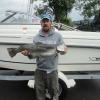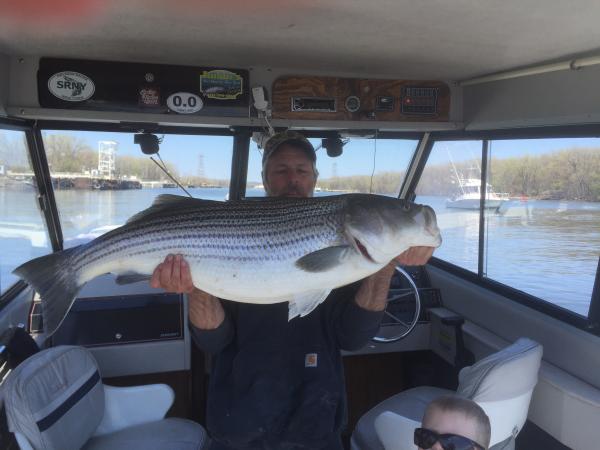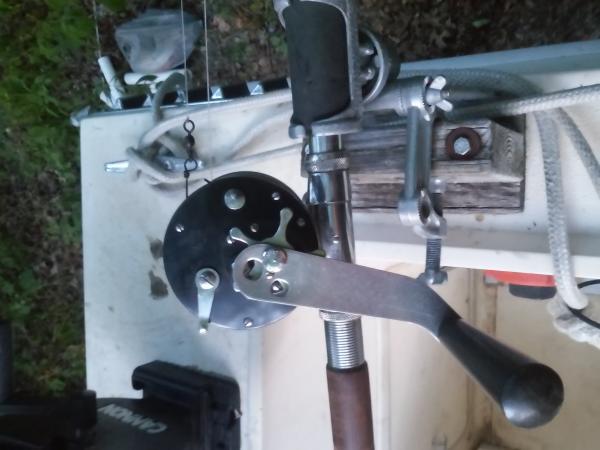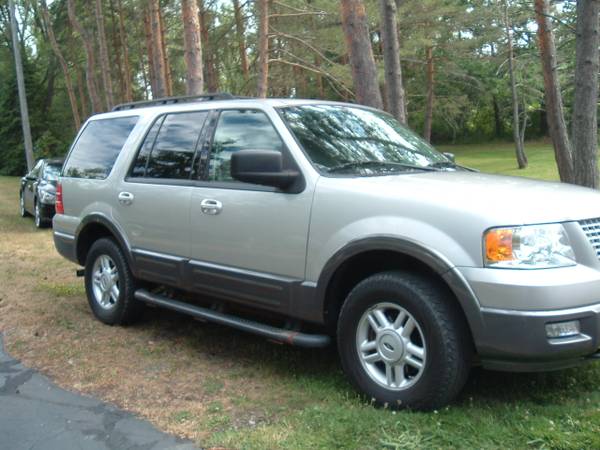-
Posts
13,873 -
Joined
-
Last visited
Everything posted by Sk8man
-
I know you said you used carb cleaner but have you tried running a can of Sea Foam through the carburator? I think the fact that the motor sat for 3 years combined with putting probable bad gas in it (even with stabilizer added 1 year is considered by many to be the longest to keep it and that is non-ethanol gas). I would be considering having the carburator rebuilt and taking the motor to a capable mechanic to evaluate....certainly cheaper than buying a new one. I can relate to your frustration though as both my main motor and brand new kicker are in for servicing.
-
Hey Stan - the shape and profile of it looks like some of the browns around here though
-
-

Dipsy Vs Downrigger
Sk8man replied to Dr W's topic in New York Fishing Reports - Lake Ontario (South Shore)
If the 47H's are the Great lakes LC model you may want to have the drag washers replaced with carbon fiber ones from Tuna Tom....it makes them into a better reel inexpensively. -
-

Dipsy Vs Downrigger
Sk8man replied to Dr W's topic in New York Fishing Reports - Lake Ontario (South Shore)
After over 40 years of using both methods I think Scott hit the nail on the head with his comment. Each method has its strengths and weaknesses on a given day and only the fish can answer "why" -

Dipsy Vs Downrigger
Sk8man replied to Dr W's topic in New York Fishing Reports - Lake Ontario (South Shore)
I know everyone has their own answer to this question.... but what if all (or most of it) of it is irrelevant? What if perhaps because our human brains think in terms of "cause and effect" we believe that our actions directly cause something to happen when in fact it may be other things going on.... ah... food for thought. What I am suggesting is that just the proximity or closeness of the lure to the fish (or group of them) by itself may be the critical factor along with perhaps lure action that appears vulnerable or easy to catch and all this other stuff that we do is just sort of "superstitious behavior" (e.g length of lead, fluoro vs. mono, distance from the ball, speed of the boat etc.) and dipsey vs. downriggers is all incidental to catching fish :lol:Then again maybe I shouldn't have had that third coffee -
Jason - Let me know the date of that last tourney and I'll try to keep an eye on things on the lake for you. I know a few years back I had to have my ss prop fixed because the water was low in the channel going out even with my lower unit up a bit ($200 for the fix ).
-
Brian makes a great point and I forgot to mention that earlier. That is what I do as well and used to have temp meters in the past as well (the old Fishawk etc.). I clip the Fishawk TD to my downrigger when I'm out in say 120 ft of water before I set my lines out and run it down to 100 ft. I have a clipboard with a sheet listing depth in 5 ft intervals covered in plastic and I use a grease pencil to record the temp at each 5 ft interval and then look at the temp profile created. When there is an established thermocline it shows as the most rapid change in temp between intervals. I set my lines so that the thermocline is located in the middle of my setup. It should be noted that sometimes the thermocline varies greatly throughout the water column as do the underwater currents so this is just a "starting point" but it usually makes a lot of difference in results knowing the approximate relationship. If I had a Fishhawk X series unit I'd be doing it in "real time" with the probe rigger and adjusting accordingly. A s far as determining the depth I'm running again it is not precision trolling like with a downrigger. I "estimate" using the known length of my rig line (e.g. 120 ft = 10x12 bead chains) and then visually estimate the amount of mainline (wire) let out while watching the angle of the wire itself in the water from the rod tip and my boat speed and adjust as needed. If you are running braid and still have the line guide present you can count the times it goes back and forth on the reel as an estimate as well.
-

Proper distance behind the balls?
Sk8man replied to Low Baller's topic in Questions About Trout & Salmon Trolling?
Sometimes it pays to experiment. In the past I found that shortening up dodger/squid, flasher/fly or spinney/fly right up close to the ball run a few feet off bottom would get them to hit. When I say close I'm talking 4 ft-8ft. What I think may be happening is that when things are presented that close together they appear as a unit rather than say the ball then a short time later the attractor coming by which may make them leery or spook them perhaps. Something to try anyway. -
Boater's advisory in effect on Canandaigua Lake Posted at 11:07 AM From the Canandaigua Messenger Post: Low lake levels mean boaters should take care near the shore. By Mike MurphyA boater’s advisory is in place for Canandaigua Lake, according Ontario County Sheriff Phil Povero. Because the level of the lake is about 1 foot below where it should be this month, boaters may strike the bottom of the lake in some areas near the shoreline, Povero said. Marine patrols will be out on the lake this weekend. Boaters who are in distress or are stranded should call 911.
-
Joe I think earlier I mentioned that rig fishing is not "precision trolling" it is more like "prospecting for fish" or trying to "cover the bases" and I guess a shotgun vs. a 22 All these methods have their place in the fishing arsenal and I still do most of them and switch off depending on the situation (e.g. Lake O vs. the Finger Lakes for example) and it pays to be versatile sometimes even in the way specific setups are put together. Probably the most important thing in all of this is to have fun at what you are doing, try to learn from our successes and failures alike, and to get better at whatever we do in the process. Good luck to all you folks fishing in the Owasco Tourney
-
You know Joe makes some real good points in his rationale for doing things te way he does and hopefully he understands my busting comments are just that because I respect his fishing abilities and share many of the same thoughts as as well despite my "old school nature" . In the interest of airing both sides of the issue of rig fishing vs. other more "modern" approaches here are some of the classic criticisms of rig fishing for those folks new to this issue: 1."you can't feel or fight the fish as well on those cumbersome heavy duty rods and lines" - To a degree it may be accurate as very small fish are sometimes carried along without it being readily apparent they are there but this is also true of downriggers and occasionally on dipseys. It may be more frequent on "jug lines" as they have a lot of inherent drag and the wave action sometimes disguises having a small fish on one of the leaders especially small lakers on the deepest leader.or when you run cowbells on it. Over the years I have modified my equipment markedly going from a large "wheel" on a wooden base in the old days where I rolled up everything including all the leaders and lures - to the use of heavy duty solid glass boat rods with a roller tip (to accomodate the ss wire main line) to the present day light duty roller rods that have a more flexible tip so that virtually every movement is detected by the rod tip (e.g. lure action as well) and there is considerable bend to it while playing fish despite it being a relatively short rod (5 1/2 ft). The reels are Penn 309's with the line guide mechanism removed so that the wire doesn't cut the brass composed in them. Some of my friends have switched to braid so that they can keep the line guide and perhaps cut through the water a bit better with their line(less "blowback"?). Several of these same type of rods serve as good dipsey wire rigs as well. 2. Another common comment is "Rig fishing offers an unfair advantage to fishermen " - I would offer that anyone trying to hand line a leader with large rainbow or landlock or multiple fish would quickly see that although the number of leaders and spoons may seem like an advantage it can be just the opposite as well as there is much more to keep track of and the probabilities af tangles are higher when inexperienced especially. It reminds me of a comment made by a lady passerby at a launch ramp back in the 70's. I had a Heath Kit chart recorder in my little Whaler (which was one of the first of its kind at the time). She asked what that "machine" was and I told her that it marked fish on the chart paper with their corresponding depth. She acted all indignant and said "That is so unfair those poor fish don't have a chance" The issue is similar just because you may have multiple lures down there it doesn't "guarantee" fish either without the experience using the approach much as interpreting the marks on the depth finder doesn't guarantee you catch the fish either. 3. The term "meat rig" has been applied (often in a derogatory way) toward the Seth Green or thermocline rig - A major reason for this is that they can be very effective in catching a wide variety of fish and if lucky higher numbers than some other techniques because the lures frequent numerous depths at the same time and much of this is a function of "probabilities" as much as anything because you are basically placing your lures above the thermocline layer where often rainbows inhabit within the thermocline where bows, browns or lakers may be located and below it where often the colder water deep dwelling lakers stay. I love trolling of all types and especially wire dipseys and riggers but if I had to depend on fish to eat for survival I would be pulling rigs, jerking copper or still fishing not using the more modern (and perhaps more exciting) techniques because over time they have a higher success rate overall. I know this is a bit long winded but I thought it might be beneficial to new comers to give a little perspective.
-
-
-
-
-
Jason hit on one of the most important things about all this stuff and that is that it can be a vehicle to make new friends and learn new things and share in the excitement of the sport as well as the learned information etc. All too often now days people are looking for spoon fed information and instant answers and solutions to their concerns or questions and it happens on LOU as well as elsewhere in life. Those of us who have been around awhile have had to learn much of this information through trial and error experimenting over the span of many years and massive amounts of time doing it figuring out which things work well or as importantly "don't work" . Many of the "old timers" I have known personally or have fished with for that matter have been very guarded with information and the general feeling has been something like " If I had to spend the time learning this stuff and putting my time in why the hell should I just give it away?" I have for many years shared that feeling but at this point in life I also feel that it is important to give back to the sport that I have loved and spent so much time learning about and enjoying along the way, and that time is very precious and if the learning curve can be accelerated for folks new to the fishing scene then I'm going to try to help them out. Does this mean I am willing to share specifics on fishing spots or particular things or techniques shared with me by friends and fellow fishermen in confidence: "no". In my view LOU is however a very special learning environment in which sharing and helping others get started or improve is desirable and essential to the vitality and life span of the sport. I am especially encouraged by the generous sharing of useful information by a number of the charter guys both on Lake Ontario and the Finger Lakes and it says a lot about them as people as well as fishermen. I think that LOU and this sharing process has helped everyone involved in different but important ways.
-
-
One of the things to keep in mind with line spacing in the classic sense is the question of: "What if my motor konks out running all this stuff .....will the leaders get into one another? If you have leaders much longer than that spacing the answer is "probably" Most guys don't run as tight as 10-12 ft between leaders more like 15 to 20 is more common. The reason I do it at 12 is so that I can for example run into much shallower water than usual (eg. 60-70 ft with 5 leaders) if I rig mine with the 12 ft intervals and I can also present the lures more like a small "school" of bait in the compressed column of water covered. This is mainly for rainbows in the top of the water column but it can also be used deep toward the bottom for lakers as well with short leaders for example. In actuality I have had to stop in the water briefly on occasion and despite my leaders being 15-18 ft long with 12 ft. spacing they have not come together but again "briefly" is the key word. If your speed is right the spoons should be running spaced close to what you have them spaced on the rig line and faster speed should throw them somewhat closer together while slowing will allow them to drop slightly and it depends quite a bit on the weight of the particular spoons as well. Thermoclining should not be confused with "precision trolling" in any case it is more like "straining" the water column in search of fish.
-

Sold / Closed 2005 Ford Expedition XLT w/78,000 miles $7900.00
Sk8man replied to MCF's topic in Classifieds - Buy, Sell, Trade or Rent
They are good towing vehicles (basically an F-150 chassis). I have a 2005 (350 motor) with 115,000 miles on it and I hardly feel my boat behind it despite the 3,200 lbs plus weight. I switched to it because of the wider wheelbase than my previous Eddie Bauer Explorer which when towing was like the tail wagging the dog going down the road -
Some additional information might get you more responses For example what type of fishing and where. It makes a difference if you will be fishing in king territory for instance. Are you going to use the rods and reels exclusively for downriggers? If so then a line counter may be unnecesary. Again, the specific line used and leader depends on where you fish and what you are targeting as well as what types of things you intend to run.
-
Things should pick up when the water temps drop. We need some cool nights without these 90 degree days. Yesterday the surface temp was almost 80 degrees. The suggestion of Cayuga was a valid one right now
-
Dan- As far as line twist the 2-3 mph as Jason stated is safe with most lures but once you get over this (unless very heavy weights are used) certain lures such as evil Eyes, Sutton 88's with a fairly wide profile or even very small lures like Quick strike 11's may wrap their leaders around the main line rather than twisting on themselves if using a good quality ball bearing swivel. This is due in large part to the fact that the main line is too horizontal in the water (e.g. blow back). Many medium sized heavier weight spoons tolerate this situation better (e.g. spoons like Northern King or Pirate 28's for example). The composition of the rig line also is a factor (e.g. more likely with mono because of resistance less so with braid or wire).





